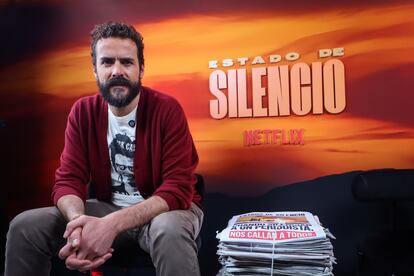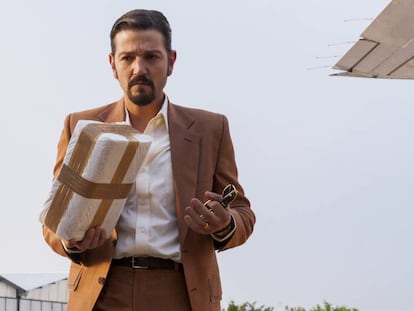Diego Luna: ‘There is violence against journalists and impunity because nothing is done about it’
The documentary ‘State of Silence,’ directed by Santiago Maza and produced by the Mexican actor and Gael García Bernal, portrays the dangerous conditions journalists face on a daily basis


On May 15, 2017, journalist Javier Valdez was stopped by a white vehicle while driving in Culiacán, Mexico. Two hooded men pulled him out of his car and spoke to him for several minutes, according to testimonies compiled by the Sinaloa Prosecutor’s Office. In his final moments, Valdez was found kneeling with his hands on his thighs, wearing a hat — an image that haunts the memory of one of the most courageous reporters covering drug-related violence in the region. He was shot 12 times. The case “should have been a watershed” to talk about justice, security and journalist protection, but it was not.
Like much of Mexican society, filmmaker Diego Luna has experienced the violence firsthand. The Valdez case posed the question of how bad things need to get before the public gets involved. “It is important we understand that what journalists are going through in our country affects us all in a way,” says Luna, an actor and the producer of the documentary State of Silence. “It is as if that was the departure point for this project that shows us what is behind the news that reaches us. That was one of the objectives — to flag up who is involved; to get us to understand, even just a little, the extent of the serious violence in Mexico.”
Directed by Santiago Maza and produced by La Corriente del Golfo — a company owned by Luna and fellow Mexican actor Gael García Bernal, the documentary was released on the Netflix platform on October 17.
It portrays four journalists who have put their lives on the line to reveal the pain and fear generated by two decades of violence unleashed by the so-called war on drugs. They are both investigators and victims. The depiction of their working lives highlights the plight of press freedom that is currently under siege in the country.

Luna explains that the initial idea was a series that would narrate the many cases of violence against journalists happening across the country. However, according to Maza, there was reluctance among the network bosses, as it was considered a “political and complicated” subject. Luna then found a way around this by presenting the idea as a documentary. Maza chose four stories. “These characters help us understand the different approaches of journalists who all experience brutal violence, precariousness and absolute solitude,” Luna says.
Journalists Jesús Medina, Marcos Vizcarra, Juan de Dios García Tavish and María de Jesús Peters explain the violence and its motives in different regions of Mexico. The idea was to encourage the public to connect and realize that wherever they are, there is a journalist at risk.
Vizcarra is one of the many voices that continue to demand justice for Valdez’s murder. “It is sad that we cannot do our job because this violence exists and will remain,” he says in the documentary. “The problem with all newsrooms is that no one teaches us to report on the pain. They didn’t care about Regina [Martínez], Miroslava [Breach] or Javier Valdez. In Mexico, they don’t care about anyone.”

The title of State of Silence — which was presented at Tribeca, in the U.S., at the Guadalajara Film Festival and at the Sheffield International Documentary Film Festival in the U.K. — reflects the complicity of local and regional authorities in the violence unleashed by organized crime. The result is “silenced zones,” with the kidnappings, assaults and murders of journalists keeping things that way.
State of Silence is an examination of “narcopolitics” in Mexico — with a look at the corruption and participation of the state in the deaths and disappearances of journalists in specific periods, such as the six-year term of Felipe Calderón, when the war against drug cartels began; the Culiacanazo in 2019 — a battle between the Sinaloa cartels and the Mexican army following the capture of Ovidio Guzmán, the son of Joaquín “El Chapo” Guzmán; the disappearance of the 43 students from Ayotzinapa in 2014 and the constant friction between the government and journalists during the recent Andrés Manuel López Obrador presidency.
Both Maza and Luna hope that the dynamics will change with President Claudia Sheinbaum’s new government. “The documentary accurately portrays the violence we have been experiencing for decades,” says Luna. “It is a violence that has increased and become more complex for various reasons. I think the documentary is a snapshot of what the country is experiencing; the levels of impunity in cases of violence against journalists…. These things happen because nothing is done.”

Luna emphasizes that it is no coincidence that State of Silence is premiering in a year of elections and a change of government in Mexico. Luna believes that the relationship between the state and the press can change, but it implies the involvement of the public, private initiatives and media bosses to ensure access to free information and “to guarantee democracy.”
“This is a documentary Marcos Vizcarra said would be great if it didn’t exist, if we didn’t have to make it,” says Maza. “In the six years since we started, we have not once taken our eye off the situation. While we were filming, the violence continued and continues today. This is a project we think is necessary to encourage reflection on a systemic problem — so that we don’t have to make another.”
Sign up for our weekly newsletter to get more English-language news coverage from EL PAÍS USA Edition
Tu suscripción se está usando en otro dispositivo
¿Quieres añadir otro usuario a tu suscripción?
Si continúas leyendo en este dispositivo, no se podrá leer en el otro.
FlechaTu suscripción se está usando en otro dispositivo y solo puedes acceder a EL PAÍS desde un dispositivo a la vez.
Si quieres compartir tu cuenta, cambia tu suscripción a la modalidad Premium, así podrás añadir otro usuario. Cada uno accederá con su propia cuenta de email, lo que os permitirá personalizar vuestra experiencia en EL PAÍS.
¿Tienes una suscripción de empresa? Accede aquí para contratar más cuentas.
En el caso de no saber quién está usando tu cuenta, te recomendamos cambiar tu contraseña aquí.
Si decides continuar compartiendo tu cuenta, este mensaje se mostrará en tu dispositivo y en el de la otra persona que está usando tu cuenta de forma indefinida, afectando a tu experiencia de lectura. Puedes consultar aquí los términos y condiciones de la suscripción digital.
More information
Archived In
Últimas noticias
Daytime, headphones, no booze involved: How a generation is saying ‘no’ to club parties
Millennia-old Yuracaré language resists extinction through 900 speakers and a new dictionary
Susan Boyle prepares a comeback just as Timothée Chalamet sings her praises
Trump suspends green card visa lottery after shooting at Brown University
Most viewed
- Christian Louboutin: ‘Young people don’t want to be like their parents. And if their parents wear sneakers, they’re going to look for something else’
- Cartels in Mexico take a leap forward with narco-drones: ‘It is criminal groups that are leading the innovation race’
- Liset Menéndez de la Prida, neuroscientist: ‘It’s not normal to constantly seek pleasure; it’s important to be bored, to be calm’
- ‘El Limones’ and the growing union disguise of Mexican organized crime
- US sanctions against jailed cartel leader ‘El Marro’ highlight Mexico’s lack of control over its prisons










































